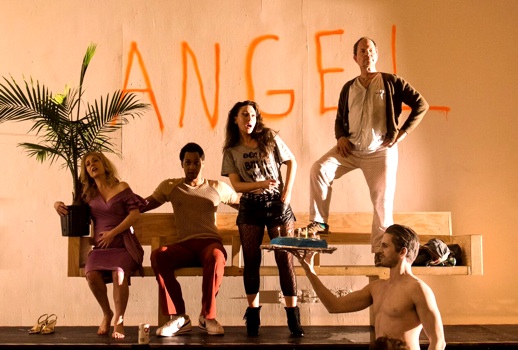

As he began with that production of Alcina last fall, Schlather continued his mission to demystify opera and its creative processes by both opening all rehearsals to the public as well as streaming themandthe final performances to the public via his website. I missed Alcina which was hailed as a revelation by many, so I was eager to experience the second installment of his journey through the three magnificent operas Handel wrote based on Ariosto’s Orlando Furioso. Although I didn’t make it to Broome Street in person to observe any rehearsals, I did watch bits of several online which were fascinating although the primitive video feed was often difficult to hear.
Schlather and his scenographer Paul Tate dePoo had configured the long, narrow gallery space at WhiteBox quite differently than they had for Alcina; a four-foot high platform was constructed running from near the front door to the back wall. About three feet deep, it served as Orlando’s “stage” although occasionally singers dropped to the floor to perform in front of or even underneath it. The only bit of “scenery” was a long, unfinished wooden bench divided into five seats. During the overture the principals entered in their vaguely-1970s attire (by Terese Wadden) and sat wearily waiting for the last subway to nowhere.
Veteran countertenor Drew Minter as Orlando looked a fright: matted hair, dirty sneakers, mismatched pajama top and bottom under a grimy overcoat. Appearing the worse for wear in her fake fur, Kiera Duffy suggested less the Queen of Cathay than the Princess Kosmopolis stumbling home from a party with her latest Chance, the young countertenor Brennan Hall, tall and thin in his see-through t-shirt, nervously pic-ing his hair.
Dorinda’s pigtails and glasses weren’t immediately visible when Anya Matanovic entered carrying a small potted palm which stayed on her lap for the first 15 minutes. And Zoroastro’s first of several incarnations was as a hardcore clone clad head-to-toe in skintight leather. Clearly we were a long way from the world of Charlemagne.
A weakness of Schlather’s unsparing concept was his occasional difficulty in finding a consistent contemporary scenario to parallel Handel’s (the opera’s librettist is unknown). The fraught triangle between Angelica, Dorinda and Medoro worked well but how to make sense of Angelica’s tortured relationship with the bedraggled Orlando? And who was this mysterious protean figure (first the leather-man, then Santa Claus, later a glitter-queen, etc.) who frequently reappeared?
The projected titles too could be problematic as there were no brave knights slaying threatening monsters, etc. Often the incongruities occasioned delirious laughter from an audience many of whom seemed unfamiliar with the tropes of baroque opera. More than once I wished that Schlather would have created updated titles mirroring his production or better yet had used an adapted, modernized English translation.
Schlather’s cast heroically performed these decidedly less-than-heroic new personas. Tall, handsome New Zealand bass-baritone Hadleigh Adams carried off Zoroastro’s extreme costume changes with poise including spending the entire third act clad only in tiny underpants while covered from head to toe in white body-make-up.
His first two arias displayed an affinity for Handel’s florid vocal line but things went badly awry in an abbreviated rendition of the celebrated “Sorge infausto.” Hall’s slightly dazed himbo of a Medoro shocked when he slapped and nearly strangled the ever-ardent Dorinda, but his sweet, high if unfinished countertenor enchanted in the sublime “Verdi allori.”
Matanovic gamely portrayed Dorinda’s constantly frustrated horniness for the conflicted Medoro, but her character suffered greatly from the omission of the exquisite “Se rivolgo al prato,” perhaps the score’s most beautiful aria.
Happily her bright soprano brought down the house with Schlather’s bravura staging of her rollicking final aria “Amor è qual vento” where the heretofore shy Dorinda threw off her inhibitions and transformed herself into a goodtime-girl ready for fun—including swiping the conductor’s t-shirt! Duffy’s stylish Angelica was heart-breaking particularly when she dropped the aging good-time girl’s faux-fur to reveal she was pregnant. She movingly transformed the usual throw-away aria “Non potrà” into an achingly honest glimpse into her tortured psyche.
The first time I ever heard a note-complete Orlando played on original-instruments was on a tape recording—which I still have—of a performance at George Washington University in St. Louis from 1983. The conductor was Nicholas McGegan, the Orlando… Drew Minter. How astonishing to witness Minter taking on the role again more than 32 years later! It would be silly to suggest that time has not marched on—the tone bit frailer, the breath more unpredictable, the coloratura more labored.
No doubt the small space and surprisingly warm acoustic aided him, but the musical sensibility has continued to deepen so that his brave Orlando was frighteningly vivid, particularly in the extraordinary mad scene which concludes the second act. Minter gave up leading operatic roles years ago to concentrate on teaching, stage directing and smaller-scale music, but his impressive return to Handel last year in Teseo was no fluke.

The small gallery space lent a startling intimacy to the performance but it also mandated a really small period-instrument orchestra whose playing was frequently compromised by scrawny strings and struggling oboes. However, Geoffrey McDonald’s graceful musical direction revealed an appealing affinity for Handel’s music and the modest ornamentation throughout was tastefully done.
Has this enterprise already become a victim of its success? With only two performances offered (preceded by a final preview), there was such a crush for tickets that premium seats for the final show were offered for $200, “rush” for $100! Of course, the show was available online for free. The plan, I believe, is to complete the Handel-Ariosto triptych at some point in the future with Ariodantewhich I suspect will suit Schlather’s talents admirably. It should be fascinating to see how his innovative process evolves—and copes.
Photos: Ian Douglas

























Comments